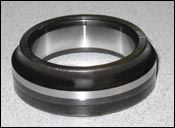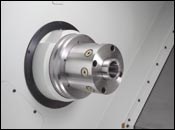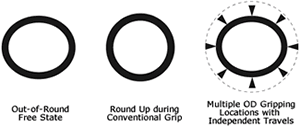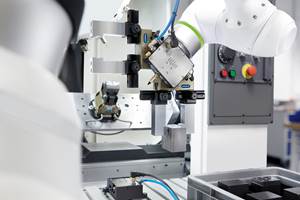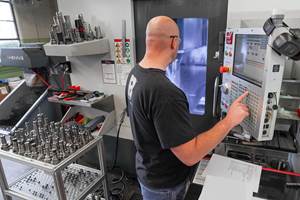Chuck Helps Restore Thin-Walled, Hardened Parts To Roundness
Heat treating can distort parts, especially round, thin-walled workpieces. During finish-turning, such components can conform to the shape of the chuck, only to spring back to an out-of-round state after clamping. Hardinge has developed a chuck with multiple gripping fingers to avoid this problem.
Heat-treating a delicate, thin-walled workpiece in order to achieve the desired hardness often results in the part coming back “out of round.” Although finish turning the part can provide some measure of roundness improvement, it is often not enough to meet specifications.
To address this problem, workholding solution provider Hardinge has developed a chuck designed specifically to tackle the problem of thin-walled, hardened parts that require high roundness accuracy. In a recent study, the company reported that a hard-turning process incorporating the chuck improved roundness approximately 10 times better than conventional workholding devices when used on the very same machines.
The problem arises during the heat-treat process, which uses time and temperature to alter the part’s microstructure—and in turn, the mechanical properties of the steel. The thermal and residual stresses that develop during the carburization, harden/quench and temper processes distort the part’s ID and/or OD, causing it to come back out-of-round.
A common strategy for addressing this problem is finish turning. During this operation, shops typically employ a conventional workholding device such as a jaw chuck, diaphragm chuck or step chuck with low gripping forces to avoid crushing or distorting the part. However, clamping the part can cause it to artificially “round up” via distortion and conform to the shape of the chuck. When the part is released, it springs back to its original out-of-round state.
Unlike traditional workholding devices, however, Hardinge’s Shape-Compliant Chuck features multiple gripping fingers that act independently to grip the part “as is” and avoid artificial rounding. To demonstrate the chuck’s effectiveness, the company conducted a study comparing its performance to that of a conventional step chuck when hard-turning bearing races.
The bearing race used in the study was a 60-64 Rc through-hardened part with an OD measuring approximately 2.25 inches (57.15 mm). The machine of choice for the application, a Hardinge Quest turning center, features hydrostatic linear guideways and a Harcrete-reinforced cast iron base. Gripping the bearing race at the machine’s lowest possible pressure setting with a conventional step chuck resulted in 1.35 times improved roundness.
However, when the bearing race was hard-bored on the same turning center with the Shape-Compliant Chuck, it maintained its out-of-round state during the cutting process, resulting in 10.9 times improved roundness. ID-to-OD concentricity was less than 0.00004 inch (1.01 micrometers). Speeds were maintained at 400 sfm at 940 rpm using CBN tooling and processed with two passes, each with a DOC of 0.003 inch (76.2 micrometers).
The particular model Shape-Compliant Chuck that was used in the study has eight gripping fingers that act independently to avoid artificially rounding the part. According to the company, other productivity benefits include rapid actuation, allowing more parts per hour; adjustable gripping forces; and high damping to reduce tool chatter and prolong tool life. Chuck models are available with an outer diameter gripping range from 0.5 to 4 inches (12.7 to 101.6 mm). They are manufactured to order by application according to applied force levels, operational speed range, grip points, jaw requirements, workpiece condition, accuracy levels and robot loading requirements.
Related Content
Simple Workholding for Robotic Automation
Robotic automation relies on reliable workholding, and these modular pneumatic jaws make it simple.
Read MoreMedical Shop Performs Lights-Out Production in Five-Axes
Moving to five-axis machining enabled this shop to dramatically reduce setup time and increase lights-out capacity, but success relied on the right combination of workholding and automation.
Read MoreShop Doubles Sales with High-Mix, Low-Volume Automation
Robots with adaptive grippers have opened entire shifts of capacity to high-mix, low-volume shop Précinov, doubling its sales.
Read MoreIMTS Takeaways From the Modern Machine Shop Editorial Team
The first in-person IMTS in four years left the MMS editorial staff with a lot to digest. Here are a few of our takeaways from the show floor.
Read MoreRead Next
The Cut Scene: The Finer Details of Large-Format Machining
Small details and features can have an outsized impact on large parts, such as Barbco’s collapsible utility drill head.
Read More3 Mistakes That Cause CNC Programs to Fail
Despite enhancements to manufacturing technology, there are still issues today that can cause programs to fail. These failures can cause lost time, scrapped parts, damaged machines and even injured operators.
Read More
